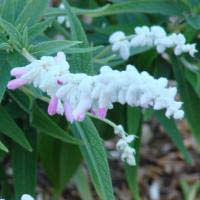Celebrity Salvias: Mexican Bush Sage Beauties

It’s a garden star, but not a demanding diva. That is why Texas A&M University selected Mexican Bush Sage (Salvia leucantha) as one of its 50 “Texas Superstar” plants, all of which are highly recommended for flourishing in unpredictable weather and drought.
The many varieties of Mexican Bush Sage are garden beauties that require lots of sunlight yet little pampering. Native to hot, dry areas of Mexico and Central America, they are accustomed to tough conditions.
Adaptable Late Bloomer
Mexican Bush Sage is recommended for USDA plant hardiness zones 8 to 11. In frost-free areas, it is an evergreen subshrub combining tender, herbaceous growth with some woodiness. In cooler areas, it is grown as a perennial or annual.
Gardeners in areas with wetter, chillier winters, such as Nantucket Island, tidewater Virginia and St. Louis, like it so much that they are willing to replant Mexican Bush Sage annually.
However, don’t expect to see flowers in spring or summer. Mexican Bush Sage blossoms fashionably late, not arriving at the garden bloomfest until autumn. But you may forgive the waiting, because the colorful, velvety foliage and flowers are likely to turn your head at a time when the landscape is fading.
Dressed in Velvet
Mexican Bush Sage is soft and hairy all over, from its square stems and silvery green, lance-shaped leaves to its flowers in shades of white, pink and purple. That’s why it is sometimes called Velvet Sage.
Depending on the height of the variety you choose, S. leucantha looks in the middle or back row of plantings. It is a particularly pretty in mixed-hedge plantings when combined with Autumn Sage (Salvia greggii), rosemary and lavender.
We’ve said it before and it’s worth saying again: The Salvia family is huge and may contain 900 species. We can’t carry all of them or their many varieties, but we can offer you what we consider to be some of the loveliest, hardiest Salvias known. These include six varieties of Mexican Bush Sage.
Mexican Bush Sage Varieties
Variegated Mexican Bush Sage (S. leucantha ‘Variegata’)
Growing 24 inches tall and wide, this petite Mexican Bush Sage is the shortest we carry. Unlike most S. leucanthas, it likes partial shade. However, similar to most Salvias, Variegated Mexican Bush Sage needs well-drained soil. Waterlogged winter roots are more of a killer than cold for any Mexican Bush Sage.
While its purple flowers aren’t spectacular, Variegated Mexican Bush Sage has standout foliage -- minty green leaves with white margins.
Midnight Mexican Bush Sage (S. leucantha ‘Midnight’)
The deep purple flowers of Midnight Mexican Bush Sage stand out against fuzzy, silvery stems. It works well in containers as well as shrubby borders.
Mexican Bush Sage (S. leucantha ‘Greenwood’)
This is one of the most popular Salvias that we sell at farmers markets. It is smaller than the standard Mexican Bush Sage from which it was cloned, but has large flowers. Place this sage in the middle or back of a flowerbed or border.
Pink Mexican Bush Sage (S. leucantha ‘Danielle’s Dream’)
Pink is not a usual color for Mexican Bush Sage. Danielle’s Dream, which originated in South Africa, features silvery white bracts and rosebud pink flowers. It is dramatic in containers as well as borders.
Santa Barbara Mexican Bush Sage (S. leucantha 'Santa Barbara')
Short, compact, and long blooming, Santa Barbara Mexican Sage toughs out heat and drought. It's an ideal groundcover.
White Mexican Bush Sage (S. leucantha ‘White Mischief’)
Similar to so many Mexican Bush Sages, White Mischief is ideal for cut-flower displays. This S. leucantha also hails from South Africa. Its large white flowers dress up velvety, minty green stems.
In addition to an increasing number of gardeners nationwide, bumblebees also vote for Mexican Bush Sage as one of their favorite plants. Plant one or more of these celebrity sages and you will attract valuable pollinators to aid your entire garden. Need to ask some questions about wildlife gardening? We're glad to share information, so please call or email us.
Updated March 19, 2018

 Salvia leucantha 'Danielle's Dream'
Salvia leucantha 'Danielle's Dream'  Salvia leucantha 'Greenwood'
Salvia leucantha 'Greenwood'  Salvia leucantha 'Midnight'
Salvia leucantha 'Midnight'  Salvia leucantha 'Santa Barbara'
Salvia leucantha 'Santa Barbara'  Salvia leucantha 'Variegata'
Salvia leucantha 'Variegata'  Salvia leucantha 'White Mischief'
Salvia leucantha 'White Mischief'
Comments
There are no comments yet.